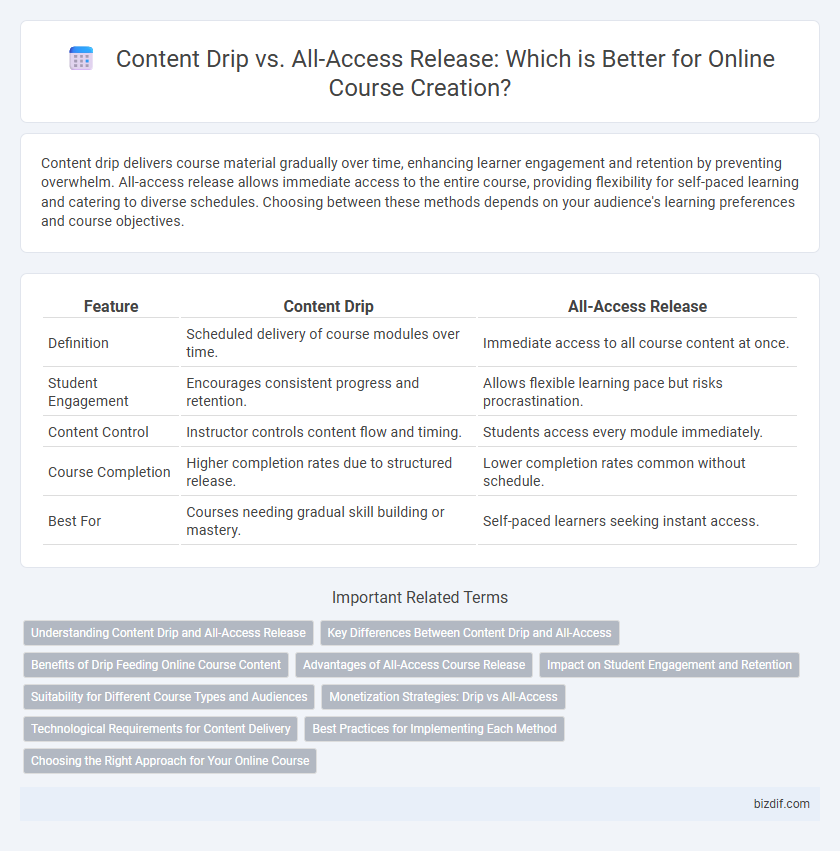Content drip delivers course material gradually over time, enhancing learner engagement and retention by preventing overwhelm. All-access release allows immediate access to the entire course, providing flexibility for self-paced learning and catering to diverse schedules. Choosing between these methods depends on your audience's learning preferences and course objectives.
Table of Comparison
| Feature | Content Drip | All-Access Release |
|---|---|---|
| Definition | Scheduled delivery of course modules over time. | Immediate access to all course content at once. |
| Student Engagement | Encourages consistent progress and retention. | Allows flexible learning pace but risks procrastination. |
| Content Control | Instructor controls content flow and timing. | Students access every module immediately. |
| Course Completion | Higher completion rates due to structured release. | Lower completion rates common without schedule. |
| Best For | Courses needing gradual skill building or mastery. | Self-paced learners seeking instant access. |
Understanding Content Drip and All-Access Release
Content drip releases course materials gradually over a set schedule, enhancing knowledge retention and maintaining learner engagement by preventing content overload. All-access release allows students instant entry to the entire course, enabling self-paced learning and immediate access to all modules. Choosing between content drip and all-access release depends on course complexity, learner preferences, and desired pacing flexibility.
Key Differences Between Content Drip and All-Access
Content drip delivers course materials gradually over time, allowing learners to absorb information at a controlled pace and increasing engagement through scheduled releases. All-access release provides immediate availability of the entire course content, empowering learners to customize their study flow and complete lessons at their own speed. Choosing between content drip and all-access hinges on factors like learner motivation, course complexity, and desired completion rates.
Benefits of Drip Feeding Online Course Content
Drip feeding online course content enhances learner engagement by delivering material in manageable, timed segments, promoting better retention and reducing overwhelm. This method encourages consistent progress, leading to higher course completion rates compared to all-access release where learners may procrastinate or skip important sections. Gradual content release also allows instructors to adjust pacing based on learner feedback and maintain sustained interest throughout the course duration.
Advantages of All-Access Course Release
All-access course release allows learners to access all materials instantly, fostering flexible self-paced study and accommodating varied schedules. This method increases learner engagement by enabling immediate exploration of advanced modules, which can boost motivation and retention. It also simplifies course management for creators by reducing the need for scheduled content deployment and frequent updates.
Impact on Student Engagement and Retention
Dripping content in online course creation enhances student engagement by pacing learning and preventing overwhelm, which fosters consistent retention and motivation. An all-access release offers flexibility but may lead to lower engagement as students can procrastinate or feel unfocused without structured guidance. Data shows courses using content drip strategies typically achieve higher completion rates and sustained learner interaction compared to those providing unrestricted access.
Suitability for Different Course Types and Audiences
Content drip suits structured learning environments such as language courses or certification programs, facilitating gradual knowledge absorption and preventing cognitive overload. All-access release benefits self-paced, exploratory learners in fields like creative arts or software training, offering flexibility and immediate access to all materials. Choosing the appropriate release strategy enhances learner engagement and course completion rates according to audience preferences and educational goals.
Monetization Strategies: Drip vs All-Access
Content drip monetization maximizes revenue by encouraging continuous engagement and reducing churn through scheduled content releases that create anticipation and sustained value. All-access release enhances immediate cash flow by offering full course availability upfront, appealing to learners who prefer flexible pacing and instant gratification. Choosing between drip and all-access depends on targeting either long-term subscription models or upfront payment strategies to optimize course sales.
Technological Requirements for Content Delivery
Content drip requires a platform with scheduling capabilities to automatically release modules at predetermined intervals, ensuring controlled pacing and learner engagement. All-access release demands a robust content management system that supports immediate and unrestricted access to all course materials, often necessitating high server capacity for simultaneous user load. Both methods benefit from mobile compatibility and seamless integration with Learning Management Systems (LMS) to optimize content delivery and tracking.
Best Practices for Implementing Each Method
Implementing content drip involves scheduling modules to release systematically, which enhances learner retention and encourages consistent engagement by preventing information overload. All-access release provides learners with immediate availability of the entire course, supporting self-paced study and catering to motivated students who prefer flexibility. Best practices for drip include setting clear timelines and maintaining regular updates, while for all-access, ensuring comprehensive course navigation and offering supplementary resources maximizes learning effectiveness.
Choosing the Right Approach for Your Online Course
Content drip delivers course materials incrementally over time, enhancing learner engagement and retention by preventing information overload. All-access release grants students immediate entry to all content, catering to self-paced learners who prefer accelerated progress. Selecting the right method depends on your course goals, learner preferences, and content complexity to maximize effectiveness and satisfaction.
Content drip vs All-access release Infographic

 bizdif.com
bizdif.com